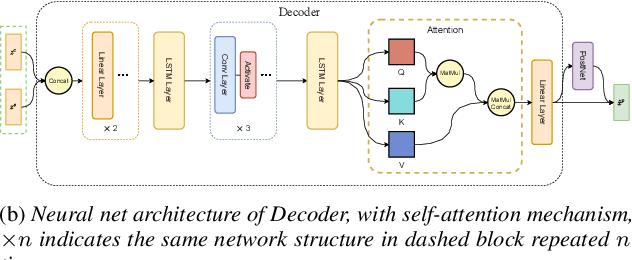Yunling Zheng
SEMA: a Scalable and Efficient Mamba like Attention via Token Localization and Averaging
Jun 10, 2025Abstract:Attention is the critical component of a transformer. Yet the quadratic computational complexity of vanilla full attention in the input size and the inability of its linear attention variant to focus have been challenges for computer vision tasks. We provide a mathematical definition of generalized attention and formulate both vanilla softmax attention and linear attention within the general framework. We prove that generalized attention disperses, that is, as the number of keys tends to infinity, the query assigns equal weights to all keys. Motivated by the dispersion property and recent development of Mamba form of attention, we design Scalable and Efficient Mamba like Attention (SEMA) which utilizes token localization to avoid dispersion and maintain focusing, complemented by theoretically consistent arithmetic averaging to capture global aspect of attention. We support our approach on Imagenet-1k where classification results show that SEMA is a scalable and effective alternative beyond linear attention, outperforming recent vision Mamba models on increasingly larger scales of images at similar model parameter sizes.
AFIDAF: Alternating Fourier and Image Domain Adaptive Filters as an Efficient Alternative to Attention in ViTs
Jul 16, 2024Abstract:We propose and demonstrate an alternating Fourier and image domain filtering approach for feature extraction as an efficient alternative to build a vision backbone without using the computationally intensive attention. The performance among the lightweight models reaches the state-of-the-art level on ImageNet-1K classification, and improves downstream tasks on object detection and segmentation consistently as well. Our approach also serves as a new tool to compress vision transformers (ViTs).
Enhancing Zero-Shot Many to Many Voice Conversion with Self-Attention VAE
Mar 30, 2022



Abstract:Variational auto-encoder(VAE) is an effective neural network architecture to disentangle a speech utterance into speaker identity and linguistic content latent embeddings, then generate an utterance for a target speaker from that of a source speaker. This is possible by concatenating the identity embedding of the target speaker and the content embedding of the source speaker uttering a desired sentence. In this work, we found a suitable location of VAE's decoder to add a self-attention layer for incorporating non-local information in generating a converted utterance and hiding the source speaker's identity. In experiments of zero-shot many-to-many voice conversion task on VCTK data set, the self-attention layer enhances speaker classification accuracy on unseen speakers by 27\% while increasing the decoder parameter size by 12\%. The voice quality of converted utterance degrades by merely 3\% measured by the MOSNet scores. To reduce over-fitting and generalization error, we further applied a relaxed group-wise splitting method in network training and achieved a gain of speaker classification accuracy on unseen speakers by 46\% while maintaining the conversion voice quality in terms of MOSNet scores. Our encouraging findings point to future research on integrating more variety of attention structures in VAE framework for advancing zero-shot many-to-many voice conversions.
glassoformer: a query-sparse transformer for post-fault power grid voltage prediction
Jan 22, 2022



Abstract:We propose GLassoformer, a novel and efficient transformer architecture leveraging group Lasso regularization to reduce the number of queries of the standard self-attention mechanism. Due to the sparsified queries, GLassoformer is more computationally efficient than the standard transformers. On the power grid post-fault voltage prediction task, GLassoformer shows remarkably better prediction than many existing benchmark algorithms in terms of accuracy and stability.
A Spatial-Temporal Graph Based Hybrid Infectious Disease Model with Application to COVID-19
Oct 18, 2020



Abstract:As the COVID-19 pandemic evolves, reliable prediction plays an important role for policy making. The classical infectious disease model SEIR (susceptible-exposed-infectious-recovered) is a compact yet simplistic temporal model. The data-driven machine learning models such as RNN (recurrent neural networks) can suffer in case of limited time series data such as COVID-19. In this paper, we combine SEIR and RNN on a graph structure to develop a hybrid spatio-temporal model to achieve both accuracy and efficiency in training and forecasting. We introduce two features on the graph structure: node feature (local temporal infection trend) and edge feature (geographic neighbor effect). For node feature, we derive a discrete recursion (called I-equation) from SEIR so that gradient descend method applies readily to its optimization. For edge feature, we design an RNN model to capture the neighboring effect and regularize the landscape of loss function so that local minima are effective and robust for prediction. The resulting hybrid model (called IeRNN) improves the prediction accuracy on state-level COVID-19 new case data from the US, out-performing standard temporal models (RNN, SEIR, and ARIMA) in 1-day and 7-day ahead forecasting. Our model accommodates various degrees of reopening and provides potential outcomes for policymakers.
A Recurrent Neural Network and Differential Equation Based Spatiotemporal Infectious Disease Model with Application to COVID-19
Jul 14, 2020Abstract:The outbreaks of Coronavirus Disease 2019 (COVID-19) have impacted the world significantly. Modeling the trend of infection and real-time forecasting of cases can help decision making and control of the disease spread. However, data-driven methods such as recurrent neural networks (RNN) can perform poorly due to limited daily samples in time. In this work, we develop an integrated spatiotemporal model based on the epidemic differential equations (SIR) and RNN. The former after simplification and discretization is a compact model of temporal infection trend of a region while the latter models the effect of nearest neighboring regions. The latter captures latent spatial information. %that is not publicly reported. We trained and tested our model on COVID-19 data in Italy, and show that it out-performs existing temporal models (fully connected NN, SIR, ARIMA) in 1-day, 3-day, and 1-week ahead forecasting especially in the regime of limited training data.
 Add to Chrome
Add to Chrome Add to Firefox
Add to Firefox Add to Edge
Add to Edge